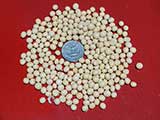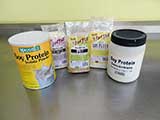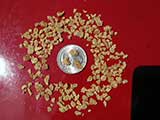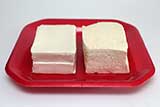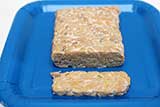Meats and Sausages
Power of Soy
Soybeans were cultivated in Asia about 3,000 years ago. Soy was first introduced to Europe in the early 18th century and to British colonies in North America in 1765, where it was first grown for hay. Benjamin Franklin wrote a letter in 1770 mentioning bringing soybeans home from England. Soybeans did not become an important crop outside of Asia until about 1910. Soy was introduced to Africa from China in the late 19th Century and is now widespread across the continent.
In America, soy was considered an industrial product only and not used as a food prior to the 1920’s. Traditional non-fermented food uses of soybeans include soy milk and, from the latter, tofu and tofu skin. Fermented foods include soy sauce, fermented bean paste, natto, and tempeh. Originally, the meat industry used soy protein concentrates and isolates to bind fat and water in meat applications and increase protein content in lower-grade sausages. They were crudely refined, and if added at above 5%, imparted a “beany” flavor to the finished product. As technology advanced, soy products were refined further and exhibit a neutral flavor today.
In the past, the soybean industry begged for acceptance, but today, soybean products can be found in every supermarket. Differently flavored soy milk and roasted soybeans lie next to almonds, walnuts, and peanuts. Today, soy proteins are considered not just a filler material but a “good food” and are used by athletes in diet and muscle-building drinks or as refreshing fruit smoothies.
Soybeans
Soybeans are considered a source of complete protein. A complete protein is one that contains significant amounts of all the essential amino acids that must be provided to the human body because of the body’s inability to synthesize them. For this reason, soy is a good source of protein, amongst many others for vegetarians or for people who want to reduce the amount of meat they eat. They can replace meat with soy protein products without requiring major adjustments elsewhere in the diet. From the soybean, many other products are obtained, such as soy flour, textured vegetable protein, soy oil, soy protein concentrate, soy protein isolate, soy yogurt, soy milk, and animal feed for farm-raised fish, poultry, and cattle.
| Soybean Nutrient Values (100 g) | |||||
|---|---|---|---|---|---|
| Name | Protein (g) | Fat (g) | Carbohydrates (g) | Salt (g) | Energy (cal) |
| Soybean, raw | 36.49 | 19.94 | 30.16 | 2 | 446 |
| Soybean Fat Values (100 g) | ||||
|---|---|---|---|---|
| Name | Total Fat (g) | Saturated Fat (g) | Monounsaturated Fat (g) | Polyunsaturated Fat (g) |
| Soybean, raw | 19.94 | 2.884 | 4.404 | 11.255 |
| Source: USDA Nutrient database | ||||
The dramatic increase in interest in soy products is largely credited to the 1995 ruling of the Food and Drug Administration allowing health claims for foods containing 6.25 g of protein per serving. The FDA approved soy as an official cholesterol-lowering food along with other heart and health benefits. The FDA granted the following health claim for soy: “25 grams of soy protein a day, as part of a diet low in saturated fat and cholesterol, may reduce the risk of heart disease.”
| Protein rich powders, 100 g serving | |||||
|---|---|---|---|---|---|
| Name | Protein (g) | Fat (g) | Carbohydrates (g) | Salt (mg) | Energy (cal) |
| Soy flour, full fat, raw | 34.54 | 20.65 | 35.19 | 13 | 436 |
| Soy flour, low fat | 45.51 | 8.90 | 34.93 | 9 | 375 |
| Soy flour, defatted | 47.01 | 1.22 | 38.37 | 20 | 330 |
| Soy meal, defatted, raw, crude protein | 49.20 | 2.39 | 35.89 | 3 | 337 |
| Soy protein concentrate | 58.13 | 0.46 | 30.91 | 3 | 331 |
| Soy protein isolate, potassium type | 80.69 | 0.53 | 10.22 | 50 | 338 |
| Soy protein isolate (Supro®)* | 92.50 | 2.8 | 0 | 1,400 | 378 |
| Source: USDA Nutrient database * Data by www.nutrabio.com. Soy isolates sold by health products distributors online usually contain 92% of protein. |
|||||
Soy Flour
Soy flour is made by milling soybeans. Depending on the amount of oil extracted the flour can be full-fat or de-fatted. It can be made as fine powder or more coarse soy grits. Protein content of different soy flours:
- Full-fat soy flour - 35%.
- Low-fat soy flour - 45%.
- Defatted soy flour - 47%.
Soy Proteins
Soybeans contain all three of the nutrients required for good nutrition: complete protein, carbohydrate, and fat, as well as vitamins and minerals including calcium, folic acid, and iron. The composition of soy protein is nearly equivalent in quality to meat, milk, and egg protein. Soybean oil is 61% polyunsaturated and 24% monounsaturated fat which is comparable to the total unsaturated fat content of other vegetable oils. Soybean oil contains no cholesterol.
Soy protein concentrates and isolates are used in sausages, burgers, and other meat products. Soy proteins when mixed with ground meat will form a gel upon heating, entrapping liquid and moisture. They increase the firmness and juiciness of the product and reduce cooking loss during frying. In addition, they enrich the protein content of many products and make them healthier by reducing the amount of saturated fat and cholesterol that otherwise would be present. Soy protein powders are the most commonly added protein to meat products at around 2-3% as the larger amounts may impart a “beany” flavor to the product. They bind water extremely well and cover fat particles with fine emulsion. This prevents fats from lumping together. The sausage will be juicier, plumper, and have less shriveling.
Soy protein concentrate (about 60% protein), available from most online distributors of sausage-making supplies is a natural product that contains around 60% protein and retains most of the soybean’s dietary fiber. SPC can bind 4 parts of water. However, soy concentrates do not form the real gel as they contain some of the insoluble fiber that prevents gel formation; they only form a paste. This does not create a problem as the sausage batter will never be emulsified to the extent that the yogurt or smoothie drinks are. Before processing, soy protein concentrate is re-hydrated at a ratio of 1:3.
Commercially processed meats contain soy protein today throughout the world. Soy proteins are used in hot dogs, other sausages, whole muscle foods, salamis, pepperoni pizza toppings, meat patties, vegetarian sausages, etc. Hobbyists have also discovered that adding some soy protein concentrate allowed them to add more water and improved the texture of the sausage.
Soy protein isolate (80-90% protein), is a natural product that contains at least 80-90% protein and no other ingredients. It is made from de-fatted soy meal by removing most of the fats and carbohydrates. Therefore, soy protein isolate has a very neutral flavor compared to other soy products. As soy protein isolate is more refined, it costs slightly more than soy protein concentrate. Soy protein isolate can bind 5 parts of water. Soy isolates are excellent emulsifiers of fat and their ability to produce the real gel contributes to the increased firmness of the product. Isolates are added to add juiciness, cohesiveness, and viscosity to a variety of meat, seafood, and poultry products.
For making quality sausages the recommended mixing ratio is 1 part of soy protein isolate to 3.3 parts of water. SPI is chosen for delicate products that require superior flavors, such as yogurt, cheese, whole-muscle foods, and healthy drinks. Soy protein isolates sold by health products distributors online usually contain 92% of protein.
Textured Vegetable Protein - TVP
Textured vegetable protein (TVP), also known as textured soy protein (TSP), soy meat, or soya meat has been around for more than 50 years. It contains 50% protein, little fat, no cholesterol, and is very rich in fiber. It is an excellent relatively flavorless filler material for vegetarian sausages. Its protein content is equal to that of the meat, but TVP contains no fat.
TVP flakes are the size of finely ground meat and they have the texture and the bite of the meat. Textured vegetable protein is cheaper than meat, and when added it can extend meat's value. Using TVP one can make vegetarian or vegan versions of traditionally meat-based dishes such as chili con carne, spaghetti bolognese, sloppy joes, tacos, burgers, or burritos.
| Textured Vegetable Protein (100 g = 1 cup) | |||||
|---|---|---|---|---|---|
| Name | Protein (g) | Fat (g) | Carbohydrates (g) | Salt (mg) | Energy (cal) |
| TVP | 50 | 0 | 30 | 8 | 333 |
| Source: Bob's Red Mill | |||||
TVP flakes or powder are usually soaked in water (1 part of flakes to 2-3 parts of water) and then mixed with sausage materials to a ratio of up to 1:3 (rehydrated TVP to materials). TVP has no flavor of its own so it can be used as a meat substitute or extender. Besides, it offers the best value for the money. You may add up to 30% of TVP. TVP is a great ingredient for making vegetarian foods. TVP is made from high (50%) soy protein, soy flour, or concentrate but can also be made from cotton seeds, wheat, and oats. It is extruded into various shapes (chunks, flakes, nuggets, grains, and strips) and sizes and is primarily used as a meat substitute due to its very low cost. When a TVP-enriched meat product is cooked, it will lose less weight as TVP absorbs meat juices and water that would normally be lost.
The small granules of TVP are easy to rehydrate but hydration rates can further be improved by using warm water. However, the mixture must be cooled down before it can be blended with other materials. Rehydrated TVP must be refrigerated and treated meat. Usually, 1 part of textured soy protein will absorb 2-3 parts of water. TVP can be mixed with ground meat to a ratio of up to 1:3 (rehydrated TVP to meat) without reducing the quality of the final product.
Textured soy flour (TSF) is obtained from regular soy flour, which is processed and extruded to form products of specific texture and form, such as meat-like nuggets. The formed products are crunchy in the dry form but, upon hydration become moist and chewy.
Tofu
Tofu, also known as bean curd is a food made by coagulating soy milk and then pressing the resulting curds into soft white blocks. Tofu is a very nutritional product unfortunately it has a very bland flavor so it can be considered only a filler material, albeit a valuable one. However, its bland flavor can be compensated for by adding natural flavors such as apple, plum, strawberry, tomato, vegetable dry powders and spices.
| Tofu (100 g) | ||||||
|---|---|---|---|---|---|---|
| Name | Protein (g) | Fat (g) | Carbohydrates (g) | Salt (mg) | Energy (cal) | Cholesterol (mg) |
| Tofu, raw, regular | 8.08 | 4.78 | 1.88 | 7 | 76 | 0 |
| Tofu, raw, firm | 15.78 | 8.72 | 4.27 | 14 | 145 | 0 |
| USDA Nutrient database | ||||||
There are many different varieties of tofu, including fresh tofu that have been processed in some way. Tofu is bought or made to be soft, firm, or extra firm. Tofu has a subtle flavor and can be used in savory and sweet dishes. It is often seasoned or marinated to suit the dish.
Tempeh
Tempeh is a traditional soy product originally from Indonesia. It is made by a natural culturing and controlled fermentation process. Like tofu, tempeh is made from soybeans, but it is a whole soybean product, which is fermented. The fermentation process and inclusion of whole soybeans result in a product with different textures and flavors. It is more difficult to create at home conditions so its suitability for making sausages is limited.
Vegetarian sausage recipes are listed in the Sausage Recipe Index

